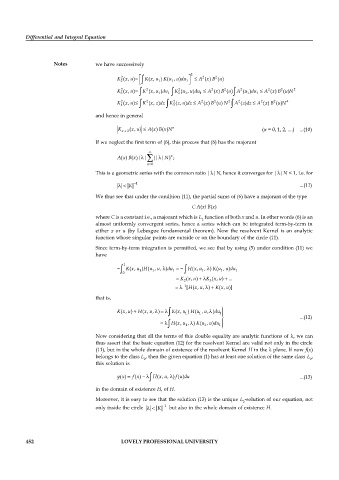Page 459 - DMTH504_DIFFERENTIAL_AND_INTEGRAL_EQUATION
P. 459
Differential and Integral Equation
Notes we have successively
2
u
x
K 2 2 ( , ) K ( , u 1 ) (u 1 , )du 1 A 2 ( ) B 2 ( )
x
x
u
K
u
K 3 2 ( , ) K 2 ( , u 1 )du 1 K 2 2 (u 1 , )du 1 A 2 ( ) B 2 ( ) A 2 (u 1 )du 1 A 2 ( ) B 2 ( )N 2
u
x
u
x
x
u
u
x
z
z
x
u
x
u
x
z
u
x
u
K 2 ( , ) K 2 ( , )dz K 2 ( , )dz A 2 ( ) B 2 ( ) N 2 A 2 ( )dz A 2 ( ) B 2 ( )N 4
4 3
and hence in general
B
x
x
u
x
K ( , ) A ( ) ( )N n (n = 0, 1, 2, ....) ...(10)
n 2
If we neglect the first term of (6), this process that (6) has the majorant
n
x
x
N
A ( ) ( )| | (| | ) ;
B
n 0
This is a geometric series with the common ratio | |N, hence it converges for | |N < 1, i.e. for
1
K ...(11)
We thus see that under the condition (11), the partial sums of (6) have a majorant of the type
C A(x) B(x)
where C is a constant i.e., a majorant which is L function of both x and u. In other words (6) is an
2
almost uniformly convergent series, hence a series which can be integrated term-by-term in
either x or u (by Lebesgue fundamental theorem). Now the resolvent Kernel is an analytic
function whose singular points are outside or on the boundary of the circle (11).
Since term-by-term integration is permitted, we see that by using (5) under condition (11) we
have
1
K ( , u 1 ) (u 1 , , )du 1 H ( , u 1 , ) (u 1 , )du 1
x
u
H
x
u
K
0
K 2 ( , ) K 3 ( , ) ...
x
u
x
u
1
x
H
[ ( , , ) K ( , )]
x
u
u
that is,
u
x
u
x
u
K ( , ) H ( , , ) K ( , u H (u 1 , , )du 1
x
)
1
...(12)
H ( , u , ) (u , )du
u
K
x
1 1 1
Now considering that all the terms of this double equality are analytic functions of , we can
thus assert that the basic equation (12) for the resolvent Kernel are valid not only in the circle
(11), but in the whole domain of existence of the resolvent Kernel H in the plane. If now f(x)
belongs to the class L , then the given equation (1) has at least one solution of the same class L ,
2 2
this solution is
u
u
x
x
y ( ) f ( ) H ( , , ) ( )du ...(13)
x
f
in the domain of existence H, of H.
Moreover, it is easy to see that the solution (13) is the unique L -solution of our equation, not
2
only inside the circle K 1 but also in the whole domain of existence H.
452 LOVELY PROFESSIONAL UNIVERSITY

